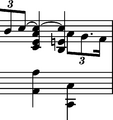



|
|
c1-a |
|
|
|
||
|
|
c1-a |
|
|
|
||

|
Possible interpretation of notation of FES |
For the 3rd crotchet in the bar we choose the unquestionable A version (→GE). The same version, yet written down with patent mistakes, is also in FE1. These mistakes – using one stem for the entire 4-part chord and doubling the bass A note – were corrected in FE2, yet the topmost note was changed from a
note – were corrected in FE2, yet the topmost note was changed from a 1 to c2 in the act. According to us, the latter is a Terzverschreibung committed while re-engraving this fragment due to the correction of FE1 mistakes. Engravers would commit similar mistakes on a few occasions in Chopin's pieces, cf. the comments on the Sonata in B
1 to c2 in the act. According to us, the latter is a Terzverschreibung committed while re-engraving this fragment due to the correction of FE1 mistakes. Engravers would commit similar mistakes on a few occasions in Chopin's pieces, cf. the comments on the Sonata in B minor, Op. 35, I mov., bar 76 and III mov., bar 30). In the preserved teaching copies the erroneous FE2 version was subject to further corrections and changes:
minor, Op. 35, I mov., bar 76 and III mov., bar 30). In the preserved teaching copies the erroneous FE2 version was subject to further corrections and changes:
- in FEJ it was probably c2 that was deleted first before adding a
 1, restoring the c1-a
1, restoring the c1-a 1 sixth, that is the A version. Next, the version with a tie to c2 was introduced;
1 sixth, that is the A version. Next, the version with a tie to c2 was introduced; - FES features a version close to the later FEJ version – on the 3rd beat of the bar, instead of the c1-a
 1 sixth, there is a c1-e
1 sixth, there is a c1-e 1-a
1-a 1-c2 chord in the R.H. According to us, the tie to the last triplet quaver, c2, could have been overlooked.
1-c2 chord in the R.H. According to us, the tie to the last triplet quaver, c2, could have been overlooked.
It is noteworthy that both copies added an a 1 crotchet on the 3rd beat, removed while proofreading FE2. What is more, FEJ restored the initial shape of melody with this a
1 crotchet on the 3rd beat, removed while proofreading FE2. What is more, FEJ restored the initial shape of melody with this a 1 crotchet, which is a strong argument for c2 having resulted from a mistake. The versions with a tie to this c2 note, written down in the teaching copies, perhaps inspired by the erroneous FE2 version, are probably meant to facilitate the performance of the chord on the 4th beat, the simultaneous performance of which could be problematic for pianists with smaller hands.
1 crotchet, which is a strong argument for c2 having resulted from a mistake. The versions with a tie to this c2 note, written down in the teaching copies, perhaps inspired by the erroneous FE2 version, are probably meant to facilitate the performance of the chord on the 4th beat, the simultaneous performance of which could be problematic for pianists with smaller hands.
The presence of the FES version in EE2 allows us to assume that the edition was revised by a person who had access to FES. The most serious candidate would be Thomas D. A. Tellefsen, Chopin's pupil, befriended with Jane Stirling and having access to her collection of Chopin's works, in which some entries are written in his hand*. In 1848-1873, Tellefsen, residing in Paris, stayed in England a few times, and, as a person close with Chopin, he could have had established cooperation with the English editor of the composer's pieces' reissue.
*After: J.-J. Eigeldinger Chopin w oczach swoich uczniów, Kraków 2010, p. 253.
Compare the passage in the sources »
category imprint: Interpretations within context; Differences between sources; Corrections & alterations
issues: EE revisions, Errors in FE, Errors resulting from corrections, Terzverschreibung error, Annotations in FES, Authentic corrections of FE, Authentic post-publication changes and variants, Annotations in FEJ, FE revisions
notation: Pitch
